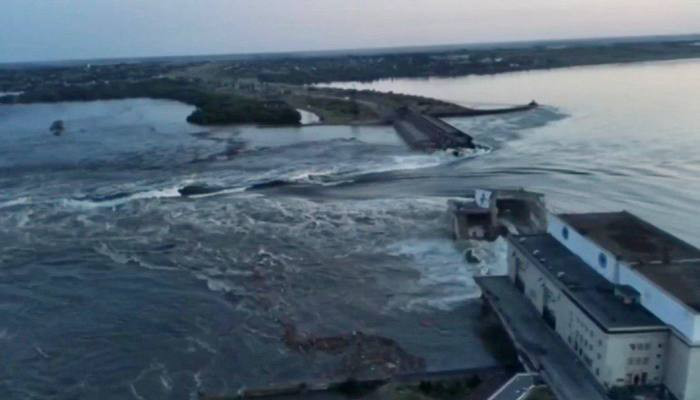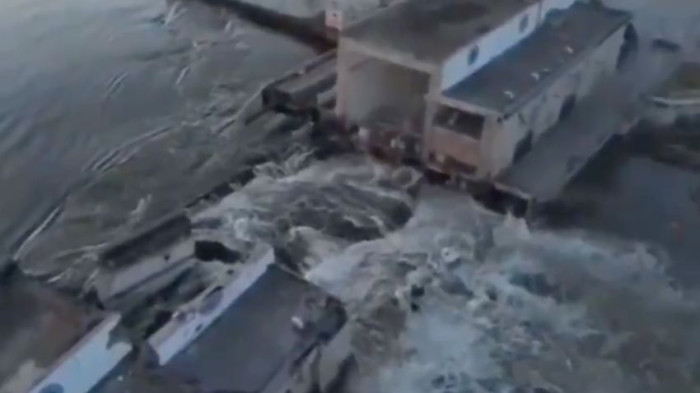Factbox: What is the Kakhovka dam in Ukraine - and what happened?
 5139 Tuesday, 06 June, 2023, 18:24 A major dam and hydro-electric power plant in Russian-occupied southern Ukraine suffered a collapse early Tuesday, prompting mass evacuations and fears for large-scale devastation as Ukraine accused Moscow’s forces of committing an act of “ecocide.” Residents downstream from the Nova Kakhovka dam on the Dnipro River in Kherson were told to “do everything you can to save your life,” according to the head of Ukraine’s Kherson region military administration, as video showed a deluge of water gushing from a huge breach in the dam. The critical Nova Kakhovka dam is the largest reservoir in Ukraine in terms of volume. It’s the last of the cascade of six Soviet-era dams on the Dnipro River, a major waterway running through southeastern Ukraine. There are multiple towns and cities downstream, including Kherson, a city of some 300,000 people before Moscow’s invasion of its neighbor. What happened? It is unclear what caused the dam to collapse, which came as Ukraine geared up for a widely anticipated counter-offensive. Both Ukrainian and Russian officials said the dam collapsed in an explosion and are blaming each other for it. Meanwhile, the Russian-installed mayor of Nova Kakhovka, Vladimir Leontiev, initially denied the dam had collapsed in an interview with Russian state media RIA Novosti, calling it “nonsense.” He later confirmed the destruction of parts of the dam in what he called “a serious terrorist act” but said there was “no need to evacuate.” CNN was not immediately able to verify the claims made by Ukrainian and Russian officials. The Kremlin on Tuesday rejected the accusations. In his regular call with journalist Dmitry Peskov said the attack was “planned and carried out by order received from Kyiv, from the Kyiv regime.” Peskov, the Kremlin’s spokesperson, said Russia “unequivocally” believes the attack was “a deliberate sabotage” by Ukraine, aiming to “deprive Crimea of water” and that the Ukraine’s caused the damage because “having launched large-scale offensive operations two days ago, now the Ukrainian Armed Forces are not achieving their goals. These offensive actions are choking.” What are the consequences? Enter your email to sign up for CNN's "Meanwhile in China" Newsletter. The damage appears to be vast and the potential devastating impact – both upstream and downstream – is worrying. Multiple towns and cities downstream from the dam are at risk of severe flooding and Podolyak had previously urged citizens to “collect your documents and most needed belongings” and wait for evacuation buses. “I ask you to do everything you can to save your life. Leave the dangerous areas immediately,” he added. The country’s President Volodymyr Zelensky said on Telegram that there were “about 80 settlements in the flood zone” and that he has ordered evacuations. The cities include Kherson, a city that was home to some 300,000 people before Moscow’s invasion.  |

At least 22 killed in collapse of two buildings in Morocco's old city of Fez (video)
96810.12.2025, 16:24
Death toll from devastating Indonesia floods hits 950 (video)
139308.12.2025, 11:31
Radio New Zealand: Children injured after chemical detergent used on daycare waterslide (video)
206705.12.2025, 10:49
Air Force pilot safely ejects before F-16 fighter jet crashes in California desert (video)
223704.12.2025, 13:25
Marine robotics firm will resume deep-sea search for MH370 plane that vanished a decade ago
206503.12.2025, 20:24
Death toll from Indonesia's floods and landslide hits 753
215302.12.2025, 14:48
Death toll from Sri Lanka floods, landslides rises to 334 (video)
191430.11.2025, 23:42
Gunman on rampage in California mall (video)
203229.11.2025, 09:53
